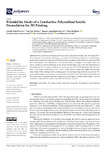Printability Study of a Conductive Polyaniline/Acrylic Formulation for 3D Printing

Use this link to cite
http://hdl.handle.net/2183/28199
Except where otherwise noted, this item's license is described as Atribución 4.0 Internacional (CC BY 4.0)
Collections
- Investigación (EPEF) [590]
Metadata
Show full item recordTitle
Printability Study of a Conductive Polyaniline/Acrylic Formulation for 3D PrintingAuthor(s)
Date
2021Citation
Arias-Ferreiro, G.; Ares-Pernas, A.; Lasagabáster-Latorre, A.; Aranburu, N.; Guerrica-Echevarria, G.; Dopico-García, M.S.; Abad, M.-J. Printability Study of a Conductive Polyaniline/Acrylic Formulation for 3D Printing. Polymers 2021, 13, 2068. https://doi.org/10.3390/polym13132068
Abstract
[Abstract] There is need for developing novel conductive polymers for Digital Light Processing (DLP) 3D printing. In this work, photorheology, in combination with Jacobs working curves, efficaciously predict the printability of polyaniline (PANI)/acrylate formulations with different contents of PANI and photoinitiator. The adjustment of the layer thickness according to cure depth values (Cd) allows printing of most formulations, except those with the highest gel point times determined by photorheology. In the working conditions, the maximum amount of PANI embedded within the resin was ≃3 wt% with a conductivity of 10−5 S cm−1, three orders of magnitude higher than the pure resin. Higher PANI loadings hinder printing quality without improving electrical conductivity. The optimal photoinitiator concentration was found between 6 and 7 wt%. The mechanical properties of the acrylic matrix are maintained in the composites, confirming the viability of these simple, low-cost, conductive composites for applications in flexible electronic devices.
Keywords
Polyaniline
UV curing
Acrylic conductive composite
3D printing
Vat polymerization
DLP
UV curing
Acrylic conductive composite
3D printing
Vat polymerization
DLP
Editor version
Rights
Atribución 4.0 Internacional (CC BY 4.0)
ISSN
2073-4360






